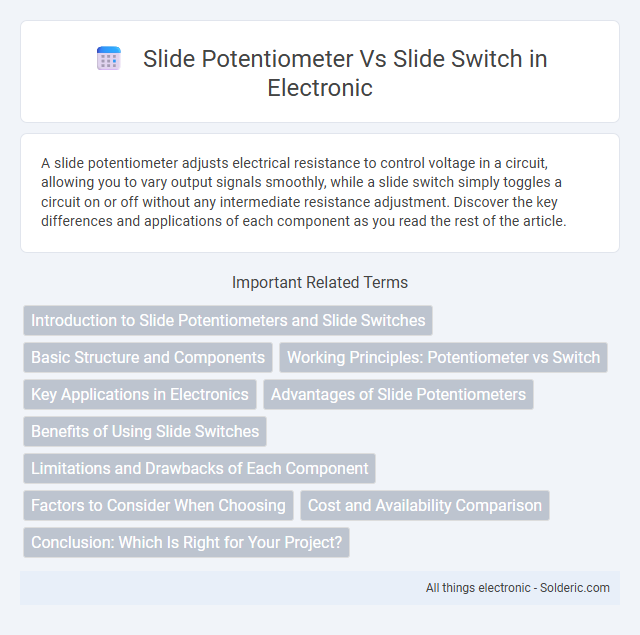A slide potentiometer adjusts electrical resistance to control voltage in a circuit, allowing you to vary output signals smoothly, while a slide switch simply toggles a circuit on or off without any intermediate resistance adjustment. Discover the key differences and applications of each component as you read the rest of the article.
Comparison Table
| Feature | Slide Potentiometer | Slide Switch |
|---|---|---|
| Function | Variable resistance for voltage control | On/off or multiple position switching |
| Output | Analog signal | Digital (open/closed) signal |
| Application | Audio volume control, light dimming | Circuit activation/deactivation |
| Adjustment Type | Continuous variable | Discrete positions |
| Electrical Contact | Resistive element sliding contact | Mechanical switching contacts |
| Typical Resistance Range | 1kO to 100kO | Not applicable |
| Size | Often bulkier, length varies with resistance | Compact, fixed size |
| Durability | Moderate; wear on resistive track possible | High; mechanical switch life focused |
| Cost | Generally higher | Generally lower |
Introduction to Slide Potentiometers and Slide Switches
Slide potentiometers and slide switches are essential components in electronic devices for controlling electrical signals. Slide potentiometers adjust resistance continuously to vary voltage or signal levels in audio equipment and lighting systems, whereas slide switches function as binary on/off devices to open or close circuits. Understanding their operational differences and applications is crucial for selecting the appropriate component in circuit design and user interface controls.
Basic Structure and Components
A slide potentiometer consists of a resistive element, a movable wiper, and terminals that allow variable resistance control, commonly used for adjusting voltage or signal levels. A slide switch features sliding contacts that open or close electrical circuits by shifting the internal mechanism between fixed positions, enabling on/off or multi-position switching. Your choice between the two depends on whether you need continuous adjustment (slide potentiometer) or discrete switching functionality (slide switch).
Working Principles: Potentiometer vs Switch
A slide potentiometer operates by varying resistance through a sliding contact along a resistive element, allowing precise control of voltage in circuits. In contrast, a slide switch functions as a binary device that opens or closes an electrical circuit by sliding a lever to connect or disconnect contacts. Understanding these working principles helps you choose the right component for applications requiring adjustable control or simple on/off switching.
Key Applications in Electronics
Slide potentiometers are widely used in electronic devices for precise volume control, audio mixing consoles, and adjustable lighting systems, offering variable resistance to fine-tune electrical signals. Slide switches serve as on/off or selection devices in circuits, commonly found in handheld gadgets, audio equipment, and DIY electronics for simple operational control. Your choice depends on whether you need adjustable input (slide potentiometer) or binary switching functionality (slide switch) in your electronic project.
Advantages of Slide Potentiometers
Slide potentiometers offer precise variable resistance control, enabling fine-tuning of electrical circuits and audio equipment with smooth, linear adjustments. Their continuous output range enhances user experience by allowing incremental changes rather than simple on/off states found in slide switches. Robust mechanical design ensures durability and reliable performance in applications requiring frequent, adjustable input.
Benefits of Using Slide Switches
Slide switches offer reliable on/off control with simple operation and durable mechanical design, making them ideal for frequent switching tasks. Their low power consumption and stable contact reduce wear and electrical noise, enhancing the longevity of your electronic devices. Unlike slide potentiometers, slide switches provide precise binary control without the need for adjustment calibration.
Limitations and Drawbacks of Each Component
Slide potentiometers have limitations such as limited lifespan due to mechanical wear and the potential for noise or signal distortion from dirt and oxidation on the resistive track. Slide switches, on the other hand, have drawbacks including a lower number of position options and potential contact bounce, which can cause unreliable switching in sensitive electronic circuits. Both components are susceptible to environmental factors like dust and moisture, which can impair their performance and durability.
Factors to Consider When Choosing
Choosing between a slide potentiometer and a slide switch depends on factors like variable resistance control versus simple on/off functionality, with slide potentiometers offering precise adjustment in analog circuits and slide switches providing straightforward binary control in digital applications. Consider electrical parameters such as voltage rating, current capacity, and durability to ensure compatibility with the specific circuit requirements. Space constraints and mounting style also influence the decision, as slide potentiometers are typically larger and used for fine-tuning, while slide switches are compact for quick toggling.
Cost and Availability Comparison
Slide potentiometers generally have a higher cost compared to slide switches due to their complex internal resistive components and variable output capabilities. Slide switches are widely available and cost-effective, often preferred in simple on/off applications because of their straightforward design. The broad availability of slide switches in various sizes and configurations typically makes them a more economical choice for mass production.
Conclusion: Which Is Right for Your Project?
A slide potentiometer is ideal for projects requiring variable control, such as volume adjustment or light dimming, offering precise and smooth input changes. In contrast, a slide switch provides simple on/off functionality suitable for power control or mode selection where discrete states are needed. Your choice depends on whether your project demands continuous input variability or straightforward switching between states.
slide potentiometer vs slide switch Infographic

 solderic.com
solderic.com